Have you ever considered installing solar panels on your roof but you don’t own your house, or do you live somewhere that doesn’t see the sun all year round? Well then, you should know that there are alternative options to generating income from the sun.
The Sun Exchange (TSE) is a platform that allows individuals to purchase solar cells (the singular modules that make up a solar panel), and lease them back to businesses such as schools, retirement homes and supermarkets.
These solar cells generate solar energy from places like South Africa and Zimbabwe, meaning that they can earn 3x the return if the cells were installed in the United States, Europe, and parts of Australia. By utilizing areas that receive constant sunlight, you can receive annual returns up to 12% (over a 20-year period (some projects offer a higher return). I want to share with you my experience of the platform, as well as how you can take climate action and create a new stream of passive income. Check out my sun exchange review below.
Affiliate disclaimer: Some of the links below may be affiliate links (disclosure). If you use these links to buy something we may earn a commission (which come at no additional cost to you). Thanks.
About The Sun Exchange
The Sun Exchange is the worlds first peer to peer solar cell leasing platform, allowing individuals from around the world to lease solar cells to businesses in emerging markets. The platform was established in 2014 through a crowdfunding campaign, with the main goal to connect the world to the sun. Since their initial offering, TSE has crowdfunded, and installed solar generation plants on over 35 different projects for industries such as schools, shopping centres, retirement villages, special care facilities and wine cellars, (to name a few). Now TSE has members in 166 countries, and has generated more than 2,000,000 kWh of solar energy.
Statistics
- Platform members in 173 countries
- over 3,300,000 kWh generated
- 980,000+ solar cells operating.

Benefits of Leasing Out Solar Cells Through The Sun Exchange
- NO WORRIES installation and maintenance is all taken care of.
- PASSIVE INCOME predictable 10-16% IRR generated each year
- LONG TERM solar panels are leased for 20 years. That’s 20 years of passive income generation.
- EASE OF WITHDRAWALS Rental returns come into your account each month. Withdrawals can be made within 24 hours.
- SUPPORTING BUSINESSES focused on reducing carbon. Help with the financial stability of underlying businesses.
- RENEWABLE ENERGY contributing to the generation of clean power.
- COMMUNITY SUPPORT supporting local jobs for installation and maintenance of solar cells.
- CRYPTOCURRENCY choose to receive your payments in cryptocurrency.
By leasing solar panels to local businesses, you provide predictable and reasonable electricity costs for the next 20 years. Each year, the rent costs of the solar panels increases at a fixed rate, which is much better than the uncontrollable cost of municipal power generated through other non renewable methods. Take a look yourself at the the current energy crisis in South Africa.
The Sun Exchange Returns – My Solar Portfolio
I have been purchasing solar panels through the Sun Exchange since the start of 2020, and have been receiving all of my solar income through Bitcoin. Each month I graph my generated power output which you can see below.
How does the Sun Exchange Work?
- The Sun exchange will identify organizations that are in need of a solar setup.
- The solar project will be funded through a crowd sale.
- Solar cells will be installed by local companies.
- The organization will pay you for the solar power consumed by your solar cells
How Do I Purchase Solar Cells Through The Sun Exchange?
It’s very easy to purchase your first solar cell and start generating solar energy. I have created a checklist here for the tools that are required, and also the steps taken to purchase cells.
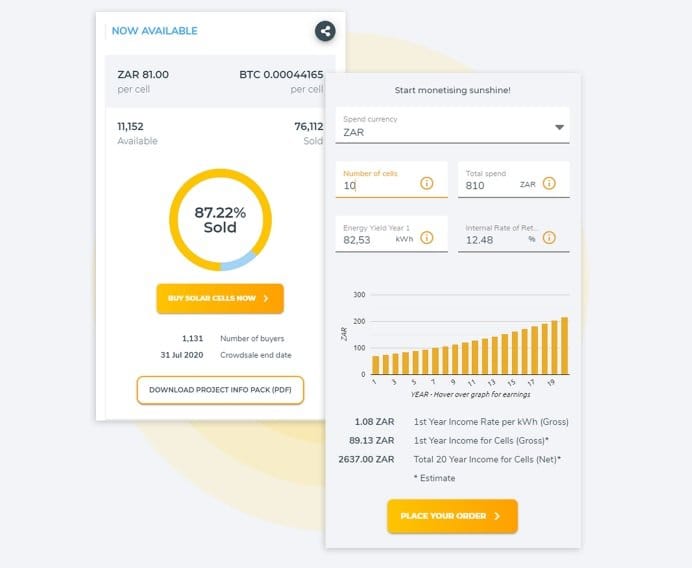
Total Time Needed :
45
Minutes
Total Cost:
5
USD
Required Tools:
Things Needed?
Steps Purchase Solar Cells through The Sun Exchange:
How to Open an Account
Opening an account on the Sun Exchange is easy. You simply have to enter your details and then click “Get Started”. From there you will receive an email welcoming you to the platform, and further instructions to get started.
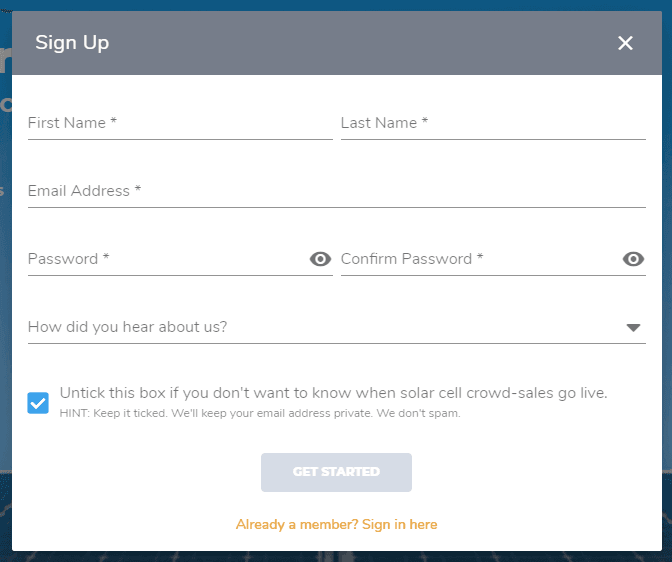
Before you can invest, you will also need to run through an KYC identity verification process, which is required under anti-money laundering laws.
Solar Projects and Expected Returns
The Sun Exchange has crowdfunded, and installed solar generation plants on over 30 different industries including schools, shopping centers, retirement villages, special care facilities and wine cellars, to name a few. One of their most recent projects expanded out of South Africa into Zimbabwe.
There isn’t usually a long wait between projects, with a couple being released each month.
Each solar project will come with:
- pictures of the industry and a map showing the location of the project
- a small blurb of information
- the cost per cell and number of investors currently in the project
- a calculator to estimate your returns for the next 20 years
- a detailed project information pack.
The expected returns can range from just over 10%, all the way up to 16%. However, the most common returns are found between 11% and 12%.
The Detailed Project Information Pack
Each project comes with a 60+ page detailed information pack that contains all of the important information that you need to know before purchasing cells.
The document includes:
- Rental income and fees
- how the rental, buying cells and getting paid works
- the most common questions (what happens if the plant breaks down, what happens after 20 years, etc.)
- manufacturer, installer and all other parties involved
- specific technical details about the plant (equipment, yield, site information)
- other documents available (i.e. rental historical payments, all contracts, insurance premiums, other relevant information)
- summary terms
- risk factors
Understanding the Payment Screen
The payment screen contains a lot of information that we will discuss below.
Order Quantity
This is where you select how many cells you would like to purchase.
Once you have entered this number, a rental income graph will be generated to project your earnings over the 20 year life of the asset.
Getting paid
This allows you to choose how you would like to receive income. Either in BTC or in the local currency ZAR.
Your Wallet
If you have some currency in your account (as a rental payment, or BTC overpayment) here is where you can specify if you would like to withdraw from here first.
Payment
This is where you choose how you will pay. You have options for Bitcoin, Credit Card, or a Deposit / Bank Transfer.
If you choose BTC, you will then be asked if you would like to purchase by number of cells, or the value of BTC
Donate
Each project has a specific charity that you can donate a percentage of you rental income to. Here is where you would specify how much you would like to donate (in %)
There is also a link to the charity page to find out more information.
After you have confirmed the conditions, you are able to place the order.
How Fast Can You Purchase Solar Cells?
My record for purchasing solar cells is currently just above 40 minutes. This is the time it takes for money to go from my bank account, convert to Bitcoin, and then complete the purchase. You should be easily able to replicate this assuming you already have an account with Coinbase and a multi currency bank account (I use Revolut), but you could also look at Wise (formerly TransferWise). My Process:
- Send EUR from Revolut to Coinbase (~5-10mins)
- Use Coinbase Pro to transfer EUR to BTC (~1 minute)
- Request to purchase solar cells (~2 mins)
- Send BTC from Coinbase Pro to The Sun Exchange (~1 min)
- The platform received the BTC and assigns it to the project (time varies ~10-20 mins)
What Happens Once I have Bought Cells?
Once you have purchased your solar cells, you will need to wait until the crowd-sale has finished. This can take anywhere from a few days, to a few months, depending on the size and complexity of the setup.
Take note: As you are purchasing and leasing out a physical asset, the cells have to be bought, installed and tested before they can generate power. This can take a month after the crowd sale has been completed.
Once the cells are installed and the system has been commissioned, you will receive the solar cell agreement, and you will start generating power. After a few days at the start of the month, you will receive your Monthly Solar Earnings Statement email, which will outline how much solar energy you have generated, and how much Bitcoin (or ZAR) you have received.
Hi Matt,
Between 30 September 2020 and 30 October 2020, your solar cell(s) generated 89.639 kWh of solar electricity.
This month, after insurance and service fees, your solar cells have earned you:
BTC 0.0***** including any pro-user bonus.
All of this information will also be replicated on your dashboard, where you can choose if you want to withdraw your earnings, or reinvest them into the next project.
The Sun Exchange Correspondence
You will be provided with many emails outlining various project information including:
- the acknowledgement of the initial cell order
- an update on when your order is complete
- an email specifying when the crowd sale is complete and when the project will go live
- the solar cell agreement
- solar cell installation updates (all projects)
- the latest video diary entry
- a monthly earnings statement
In addition to the email correspondence, there is an official telegram group that will share pictures of installation and completion works for each project. Both Abe (the CEO) and Barrett (sun exchange guru) are actively responding to questions and other various topics.
Withdrawals
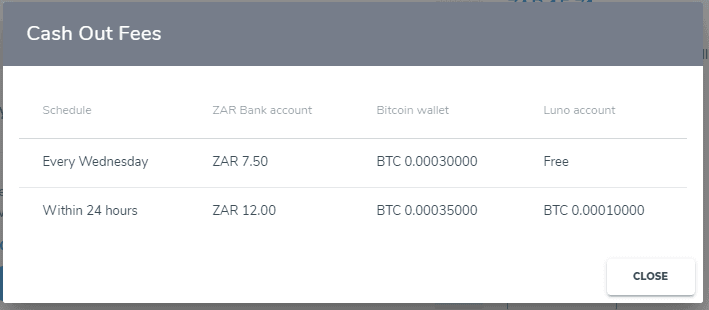
Withdrawals are processed once a week (each Wednesday), or can be processed faster for a small fee. If you are using a Luno wallet, withdrawals are free once a week.
Please note: withdrawals may be counted as a “taxation event” in your country. Depending on how your country taxes these earnings, there could be advantages to keeping your funds in the platform and using those to purchase additional solar cells, and compound your monthly earnings. Seek appropriate financial advice to determine when you would be required to pay taxes.
Paying with Bitcoin – Number of Cells or Value of BTC?
If you choose to pay for your solar cells with Bitcoin, you have two options for how you can pay. (1) you can pay by the number of cells, or (2) you can pay by the value of Bitcoin.
(1) Paying by Number of Cells
Likely the most common way of purchasing solar cells is by selecting how many cells you would like, and then sending the BTC that matches that price. This is the best way if you need a specific number of cells. The order is process once the payment has been received.
The Sun Exchange recommends that if you don’t usually hold Bitcoin, it may be wise to pay by the number of cells.
(2) Paying by Value of Bitcoin
As the title suggests, there is an option where investors can choose to invest by the value of Bitcoin, instead of specifying the number of cells. All value orders are processed at the end of the crowd sale, and the amount of cells you purchase will depend on the BTC price when the sale is ending. This could be a good option if you think BTC will go up over the space of the crowd sale.
Paying by South African Rand
The platform also offers payments in the local currency – ZAR. This is probably a good option if you live in South Africa, but would be less cost effective if you live outside South Africa.
What happens after the 20 year lease period?
After 20 years a re up, the solar cells will be nearing the end of their design life. TSE will assist with negotiating a further term of 5 years, or will sell the cells and the system to the customer for a specified value which will be returned to the initial purchasers.
My Preferred Setup
By far my best low cost setup that I have found is to:
- purchase BTC through Coinbase Pro (see how to do that here)
- pay for panels in BTC
- receive BTC payments each month
- reinvest at the current price of BTC, OR cash out into Luno wallet then move to another storage type.
Obviously your situation may be different to mine, and you may find a process that meets your needs..
Charity Options
When purchasing solar cells through TSE, you have an option to donate a percentage of your solar cell lease income to a charity. Charities very between projects, as they have been nominated by the organization.
The Management Team Behind the Sun Exchange
Founder CEO – Abe Cambridge
Abe has a background in climate change science Abe built and worked at a solar panel installation company in the United Kingdom before moving to South Africa to work as a solar engineering consultant. During this time he realized that there was a gap in the solar market.
Managing Director – Lisa Lyhne
Lisa is an entrepreneur with over 30 years of experience, founding and developing multiple software companies throughout Europe and South Africa.
Chief Financial Officer – Saul Wainwright
Saul has worked for 20 years in Silicon Valley helping many startups with their financial and legal issues.
More members of the team can be found on the teams page, and various biographies of each member can be found in the sun exchanges blog.
Drawbacks from The Sun Exchange

There are many benefits of investing in The Sun Exchange, however there are also some things that need to be taken into consideration before you purchase cells:
- South Africa sometimes suffers rolling power cuts (load shedding). When this happens, the majority of solar projects disconnect the power for safety and technical reasons. This means that during load shedding periods, there may be a reduction in expected solar generation. The solar projects that have a backup AC generator (like the Boland Wine Cellar), will continue to run normally during load shedding events.
- The exchange rate between USD and ZAR is variable. Over the last 10 years, the rate has fallen quite substantially. in 2010, 1 ZAR was worth $0.15 USD, and in 2020 that same 1 ZAR was only worth $0.06 USD.
That means over the 10 year period ZAR has lost nearly 2/3 of its value. The flip side is that if the South African Rand gets stronger, then it could actually be a benefit.
This affects all payments including BTC as this rate is initially determined in ZAR. However, some projects (i.e. Nhimbe Fresh) are tied to USD and not ZAR. Currently there is only one project tied to USD. - The platform is only a few years old, and the projects have a 20-year expiry. No one knows what will happen after the 20-year period, including whether the panels will be:
- leased for an extra 5 years (increasing the IRR),
- sold (which allows a capital loss),
- thrown out,
- or whether TSE will still be in operation.
- There is a couple of months lag time between purchasing your cells, and seeing income being generated. Don’t forget that you are paying for actual solar equipment to be fixed to a roof of a company or school. These things don’t happen overnight.
Due Diligence
Whenever you are investing in a new platform, you must take some form of due diligence. There are many things to love about this platform in particular including:
- Good communication, this is shown with the multiple updates, picture evidence, and the regular emails.
- Knowing the team. The team do not hide. You can easily find and communicate with members of the team through various channels. The CEO of the platform (Abe Cainbridge) speaks at many clean and sustainable energy gatherings.
- Manageable projects. There have only been a few projects at a time, implying that the platform are taking care in selecting the projects, and are not taking on more than they can process.
- Transparency. There is physical evidence of solar cells being installed on top of the various businesses. Feel free to get in contact with the schools, supermarkets and other business entities if you need more proof.
Note: Before investing in this platform, or any other investment platform, it is important to undertake your own due diligence about the product. The due diligence that I have conducted here only looks at some aspects of the investment/platform. By no means does this article constitute a full due diligence on the investment mentioned. This article that I have written in no way forces you to invest.
Sunex Tokens
What are SUNEX tokens?
SUNEX tokens are ERC-20 compatible blockchain rewards that were allocated to early (2018) investors in the Sun Exchange platform. During this time, over 31 million tokens were allocated to expand and grow the platform. However, since 2018 there has been no mention of the SUNEX tokens, as the program is still under development. Once implemented, SUNEX tokens can be earned by purchasing solar cells and generating solar energy through TSE.
What Can I get with SUNEX Tokens?
Once implemented, those that hold SUNEX tokens can obtain many benefits on the platform, including discounts on cells, increased return on solar energy generated and options to purchase cells in systems before they become public. With more tokens, comes more benefits!
SUNEX Benefits
According to the whitepaper, there will be 6 different tier levels that provide various bonuses to your solar purchases.
TIER | SUNEX Required | Lease BOOST (%) | Purchase DISCOUNT (%) | Purchase Priority |
|---|---|---|---|---|
Ra | 200,000 | +5% | +5% | 1 |
Super Nova | 100,000 | +2.5% | +2.5% | 2 |
Hyper Giant | 50,000 | +2% | +2% | 3 |
Giant Star | 25,000 | +1.25% | +1.25% | 4 |
Dwarf Star | 1,000 | +0.1% | +0.1% | 5 |
Hydrogen | 0 | 0 | 0 | 6 |
Solar Cells vs SUNEX tokens
There can be confusion when looking at the differences between solar cells and sunex tokens. Here is some clarification:
- Solar Cells = Physical Assets that generates solar energy, and in turn generates passive income for the owner.
- SUNEX token = Blockchain Asset that provides certain benefits when using TSE.
For further clarification read this article: Solar cell vs SUNEX token purchases.
The Sun Exchange VIP Program
Have you ever wondered why some of the solar cells are already sold as soon as the project has come online?
It is because those with the VIP label have had 48 hours access beforehand.
How Do I Become a VIP?
VIP privileges have awarded on two previous occasions. (1) during the initial release of the platform, and (2) when The Sun Exchange tried to raise an additional round of funding through Uprise Africa.
Unfortunately there is no current ways of becoming a VIP.
Concluding Remarks
The Sun Exchange provides a perfect platform for anyone in the world to be able to generate passive income from the sun. You don’t need solar panels installed on your own house. You could be living in an apartment or a rental property, or in a place that doesn’t get any sun at all. It actually doesn’t matter. The cells purchased are all placed in areas that DO receive a lot of sun.
If you’re like me you can use the money generated to help offset your own electricity costs. One of the fastest ways of achieving financial independence is by utilizing investments and passive income to pay for expenses such as recurring bills. Using your assets (i.e. your solar cells) to pay off your liabilities (i.e. you electricity bill).
As mentioned above, the platform is still very new, so its hard to see the effects over the long term. It is however great to receive a passive income stream of BTC each month. With BTC being more widely accepted in society, it seems like this could be a winning combination.
Another advantage that I didn’t mention above (as this will affect everyone differently) is the advantage of taxation. After 20 years the panels will either be extended for another 5 years (increasing the IRR), or will be sold off, to the borrower. If the cells are sold off for a lesser value than their purchase cost, then the initial investment can be written off as a tax deduction (Where I am from), meaning that in year 20, I wouldn’t need to pay tax on investments equal to the difference in my purchase price and the selling price. This is obviously different for everyone, and you should find out your own tax advice in these matters.
I have been able to partner with The Sun Exchange, and can offer you a free solar cell if you choose to invest through this link.

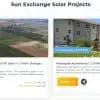

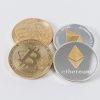
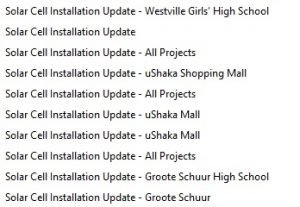
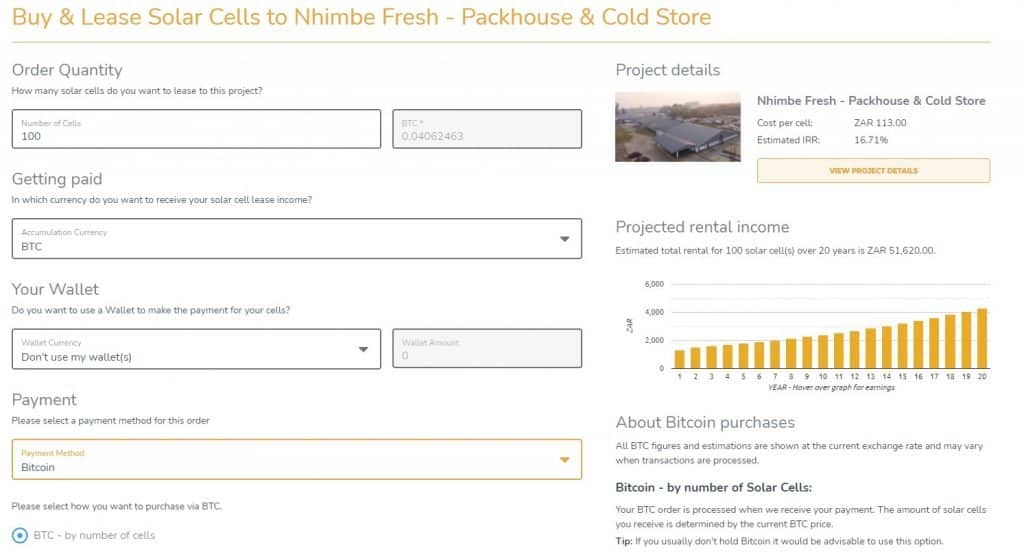

I used your link, how do I confirm that I get the free panel?
Thanks
Hi Joel.
The cell is usually distributed in the week following your first purchase. It’s currently a manual process so can sometimes take a bit longer depending on work load.
You will get an email once it has all been processed! Let me know if you haven’t heard anything after a week, and I can chase it up!
Matt
Hi,
As the payment options are rather strange, canyou tell me what fees are there if i plan to invest via Credit Card in all Projects?
Regards
Tom
Hi Tom,
I’m just had a quick look on the purchase page now and it seems like using a credit card adds a fee of about 3.25%. I’m sure that’s also probably written somewhere, but I wasn’t able to find anything.
I once tried using a bank transfer (using Revolut for the currency exchange) but I was hit with an extra ZAR 149.99 (~10 USD) in bank fees.
I think the cheapest way to go is by using Bitcoin, however I understand that BTC is so volatile at the moment.
Hope that helps!
Matt